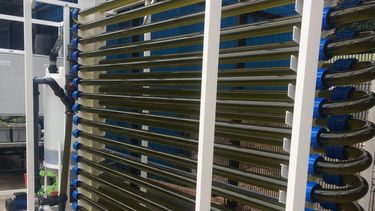Pondering on algae with new photobioreactor
Despite improved recycling infrastructure and public awareness, the UK still sends a staggering 17 million tonnes of municipal solid waste into landfill every year. This leads to the build-up of leachate, the liquid which drains from a landfill site.

Leachate contains trace chemicals, which can have strong contaminating effects on the environment and effective treatment methods are required. Dr Pandhal’s research project aims to demonstrate an integrated process for leachate treat waste and resource recovery.
Viridor Waste Management Ltd is the third largest waste management organisation in the UK, owning over 40 sites. Approximately half the sites use foul sewers to carry contaminated wastewater to a sewage works for treatment, the rest is either transported using tankers or released to surface waters.
Dr Pandhal’s research will see pre-processed leachate fed into a photobioreactor and growth and operating parameters carefully monitored.
“For the last two years we have been culturing microbial consortia isolated from a landfill leachate pond - a site close to Sheffield. We’ve been optimising the consortia to be able to interact more synergistically, exchanging nutrients and ultimately growing faster, and thereby improving detoxification of leachates. We engineer the community and not individual cells.”
“The department recently saw an installation a new 400 litre photobioreactor at the Arthur Willis Environment Centre (AWEC), for those that don’t know a photobioreactor is a bioreactor that utilizes a light source to cultivate phototrophic microorganisms.”
The algal biomass can subsequently be utilised as a resource, from fuels to plastics, as well as recovering metals. Now we aim to illustrate this at scale and perform a techno economic assessment with our collaborators.
Dr Jagroop Pandhal
Professor of Microbial Systems Engineering
“These organisms use photosynthesis to generate biomass from light and carbon dioxide and include plants, mosses, macroalgae, microalgae, cyanobacteria and purple bacteria. Within the artificial environment of a photobioreactor, specific conditions are carefully controlled for respective species. A photobioreactor allows much higher growth rates and purity levels than anywhere in nature or habitats similar to nature.”
He goes further to explain the data from the photobioreactor will be used in a techno economic assessment for Viridor but also other end-users. An easy-to-use Resource Recovery calculator will also be created. The process will be filmed and used to make a video for knowledge exchange and educational purposes.
“The ultimate aim is to demonstrate the progress of the NERC funded research up technology readiness levels with industrial, societal and environmental impact, together with economic benefits for the project partner and wider waste management community.”
So, when you next throw your rubbish into a bin, you can spare an extra second imagining its journey to a landfill site, components of it leaching into a pond and subsequently providing food for our algal consortia, which will provide multiple resources for you to meet on a shop's shelf again.
